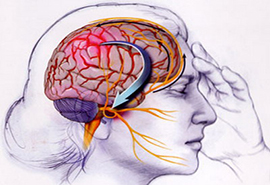
Migraine
A migraine is a very painful type of headache. People who get migraines often describe the pain as pulsing or throbbing in one area of the head. During migraines, people are very sensitive to light and sound. They may also become nauseated and vomit. Migraine is three times more common in women than in men. Some people can tell when they are about to have a migraine because they see flashing lights or zigzag lines or they temporarily lose their vision. Many things can trigger a migraine. These include:
• Anxiety
• Stress
• Lack of food or sleep
• Exposure to light
• Hormonal changes (in women)
Doctors used to believe migraines were linked to the opening and narrowing of blood vessels in the head. Now they believe the cause is related to genes that control the activity of some brain cells. Medicines can help prevent migraine attacks or help relieve symptoms of attacks when they happen. For many people, treatments to relieve stress can also help.
Introduction:
Headaches are a very common condition. They are one of the most common health complaints. A migraine is a very specific type of headache. Not all headaches are migraines. This health information will help you understand what a migraine headache is and how migraines can be treated.
Classical Migraine Headaches:
Migraines usually start in childhood and may either get better or worse with age. There are two generally recognized types of migraine headaches. The first one is the classical migraine headache and the other is the common.
The common migraine headache, as its name suggests, is more common than the classical one. A classical migraine headache typically starts with some visual disturbances. The patient sees spots, dots, or even zigzag lines. These disturbances are called auras. An aura is usually followed by a severe headache, usually on one side of the head only. A migraine headache is generally made worse by noise, light, and activity. Migraine headaches may range in length from half an hour to several hours or even several days! Nausea and vomiting may accompany a migraine headache. Classical migraines may include short-lived but extreme neurological effects. They can cause the patient to be paralyzed on one side of the body for a few minutes or longer.
Common Migraine Headaches:
Not all migraine headaches are of the classical type. A good number of migraine headaches are atypical, meaning one or more elements of the classical migraine may not be present. These are also known as common migraines. Common migraines may involve the whole head, instead of only one side. Some migraines may cause visual changes, nausea, and vomiting but no headache.
Causes:
The exact cause of migraine headaches is still unknown. Doctors used to believe migraines were linked to the opening and narrowing of blood vessels in the head.
Now they believe the cause is related to genes that control the activity of some brain cells.
Triggering Factors:
Certain events can trigger migraine headaches for certain people. When patients are aware of triggering factors, they should avoid them if possible. In some patients, certain types of food or drink may trigger migraines. Examples of dietary triggers include:
• Chocolate.
• Cheese.
• Food additives such as MSG, found in some Chinese foods.
Smoking and drinking alcohol are common triggers for migraines. Certain medications may start migraine episodes as well. Stress and being overweight can both contribute to migraine episodes.
Treatment:
There are 2 main ways to treat migraines:
1. Take medications that cause episodes to be shorter.
2. Take pills on a daily basis to reduce how often migraines occur.
Many people with migraines use both approaches. Patients take medications originally developed for epilepsy and depression to prevent future attacks, and treat attacks when they happen with drugs called triptans that relieve pain and restore function. Regular over-the-counter medication may also be used, such as Tylenol® or Advil®. Relaxation and a dark, quiet room can be combined with medicine to treat the headache. If over-the-counter medications do not help, stronger prescription medications may be needed. Some migraine headache medications may not be recommended for people with heart conditions or other medical conditions. Since most migraine medications can have side effects, patients should follow up regularly with their doctor. Hormone therapy may help some women whose migraines seem to be linked to their menstrual cycle. Stress management strategies, such as:
• Exercise.
• Relaxation.
• Biofeedback.
Other therapies designed to help limit discomfort may also reduce the occurrence and severity of migraine attacks.
Prevention:
Preventing migraines can be effective, especially if triggering factors are known. Not smoking, not drinking alcohol, and not eating certain types of cheese may also help reduce the number of migraines. Staying relaxed, in shape, and not being overweight also helps to prevent migraines. Migraines are fairly similar from episode to episode. If the nature of the attacks changes, a doctor should be contacted because it may be a sign of a more serious type of headache.
Summary:
Migraines are a very common condition that sometimes runs in families. Determining what triggers migraines in each specific case is extremely important in preventing them. Fortunately, recent advances in medicine have discovered effective treatments for migraines.
Medications associated


